Do you want to be a mechanical engineer and start building things? Then, here are the important measuring tools that you need to know!
Every gadget that you love using has gone under different measurement tools to acquire the perfection it carries today. We tend to forget the importance of these tools unless we are engaged in a technical field like engineering where we create things from scratch. Similarly, laser measuring tools for professionals or beginners are simple yet revolutionary instruments made by engineers.
It is here that we realize the importance of knowing different measurement tools and how significant they are. If you have no idea what we are talking about, then join us as we make your job easier. We have compiled a list of measuring tools used in mechanical engineering and a brief explanation highlighting their use.
Listed below are measuring tools for engineering:
- Measuring Tape: A tape measure is often seen in engineers’ toolboxes due to its versatility and portability. Its adjustable length allows for a broad range of distance measurements, reinforcing its universal utility.
- Vernier Calipers: Slide calipers are used in precision-demanding fields like mechanical or manufacturing engineering. The ability to measure internal, external, and depth dimensions with a single device underscores its ubiquitous application.
- Steel Ruler: An engineer’s steel ruler delivers straightforward linear measurements making it popular across engineering disciplines, from the drafting of designs to deriving basic linear dimensions.
- Laser Tape Measure: The laser distance meter blends traditional functionality and modern technology. From measuring the length of a football field or the height of a 10-story building, it shines.
- Radius Gauge: A fillet gauge is an engineering tool with a specialized function of measuring radius, like rounded corners of tables or mobile phones.
1. Measuring Tape
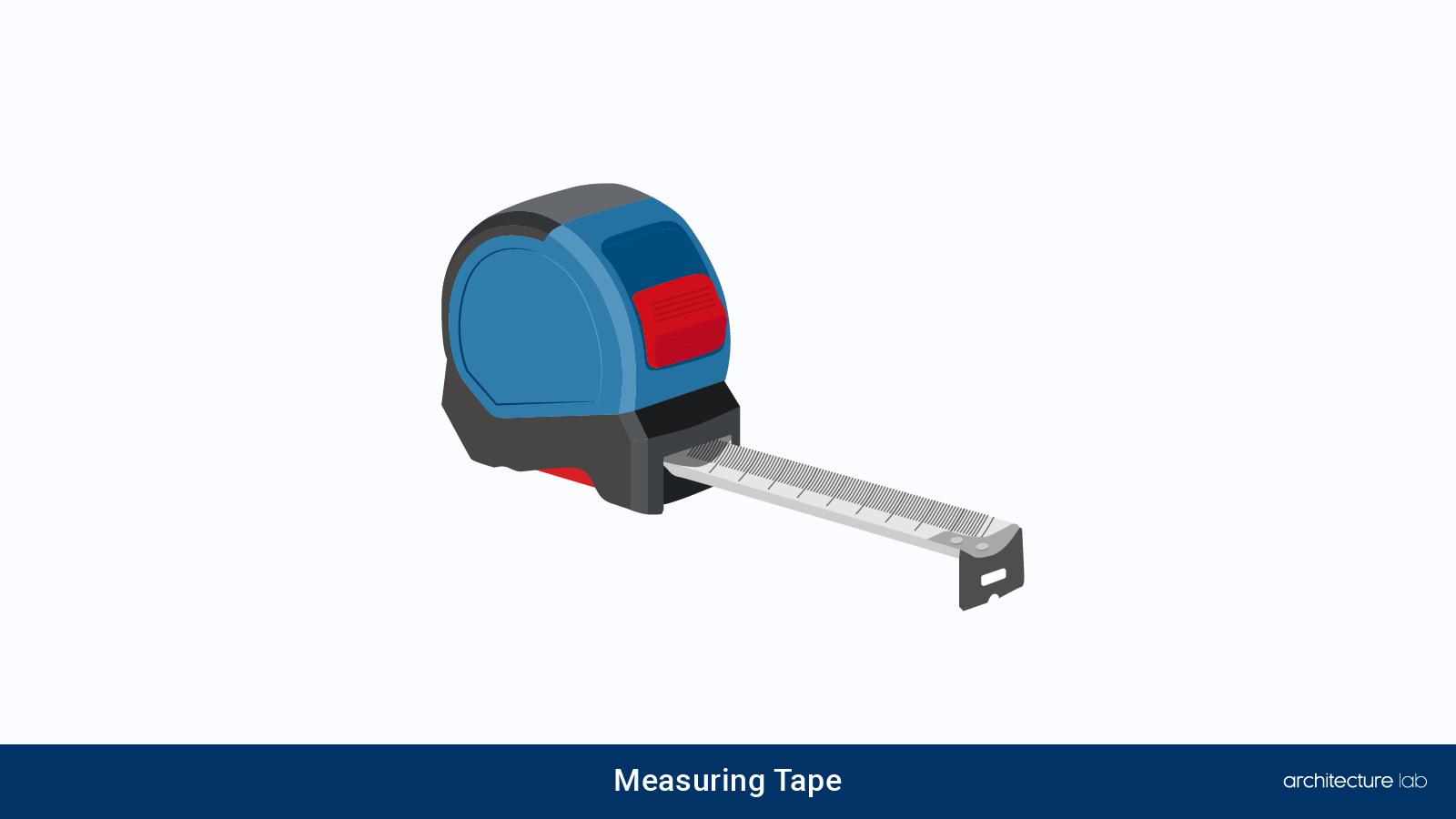
A measuring tape is a flexible measuring instrument used to measure linear dimensions. The units of measurement are indicated on the tape, and it’s an extremely easy tool to work around, especially when it comes to measuring distance.
The tape comes in different materials, including cloth, plastic, metal, and fiberglass.
2. Steel Ruler
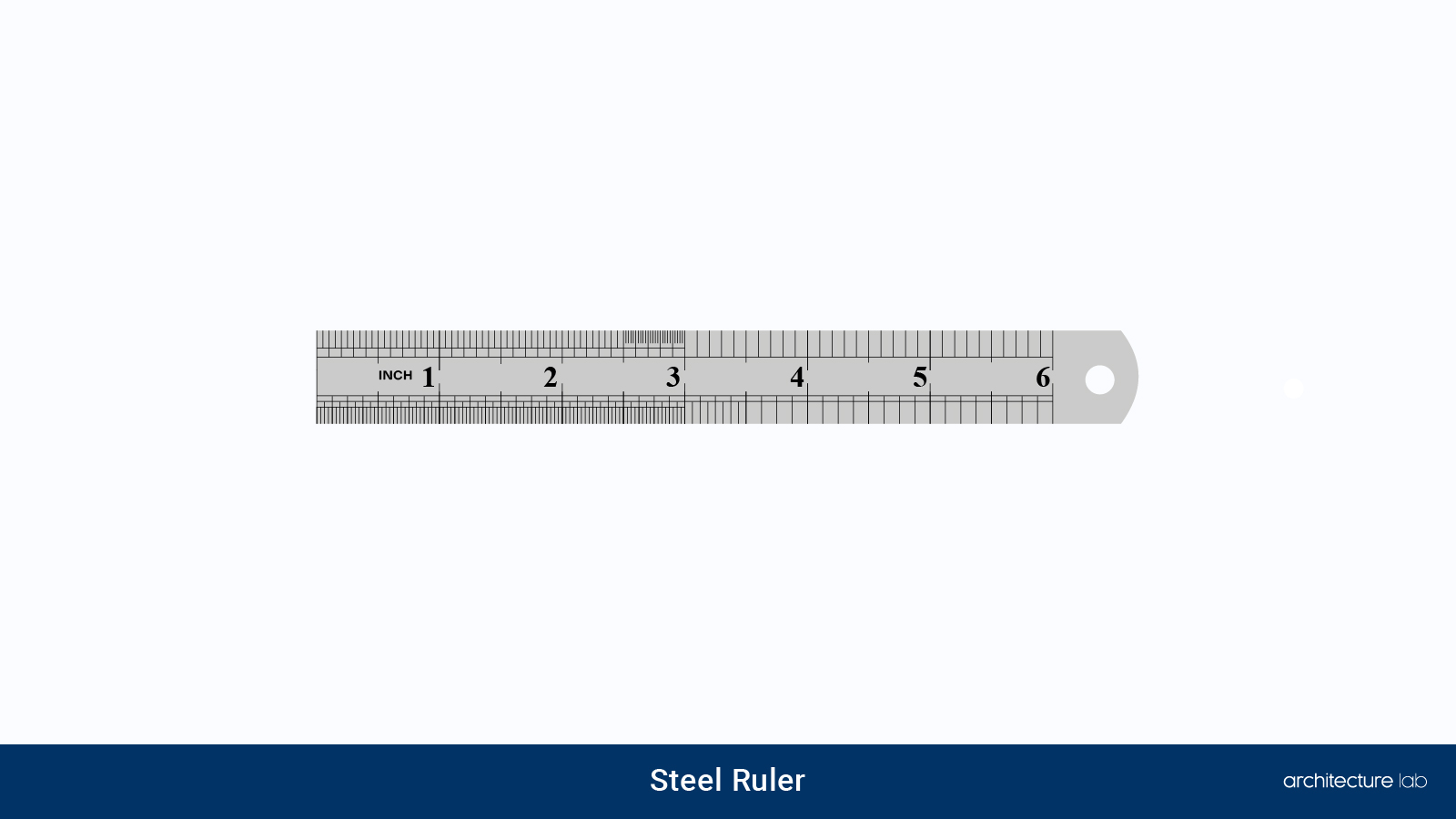
The engineer’s steel ruler is another measuring instrument used for measuring the linear dimensions, i.e., length, height, and width of objects. Usually, it is available in lengths of 6 or 12 inches. However, you can also find longer steel rulers.
The steel ruler measures objects (or gives specimens) in inches and cm. Both these units are on either side of the scale. The least count (reading accuracy) of the steel ruler is 0.5mm.
3. Vernier Calipers
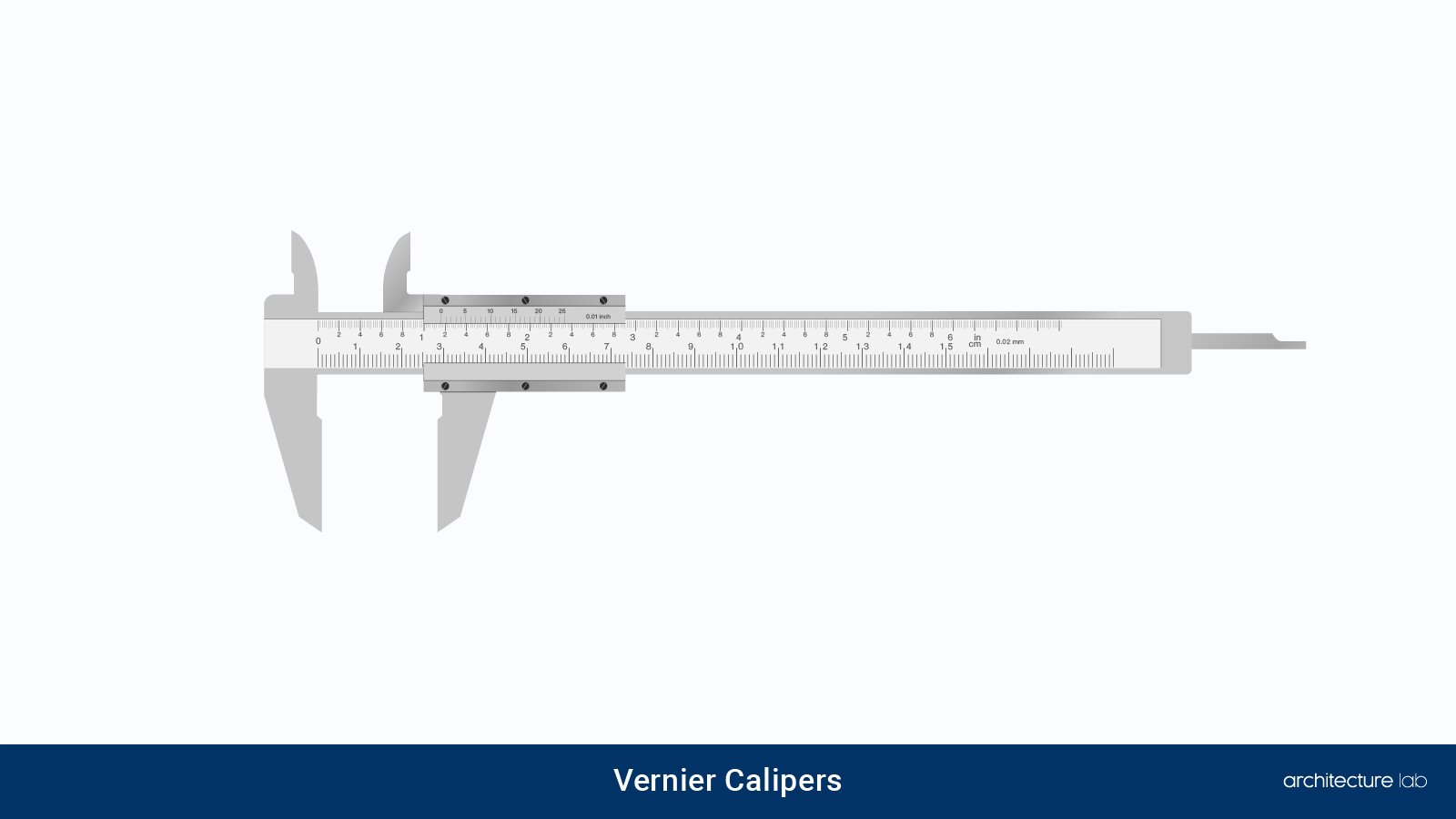
Vernier calipers are precision instruments used for linear measurements. The measuring jaws (external and internal) of a vernier caliper are used to measure the diameters of circular specimens. The external and internal dimensions of a surface can be measured accurately with a reading error of 0.02mm only. However, it’s important to place the caliper at a right angle to appropriately measure the object.
If there’s an error in the reading of the vernier caliper, then such an error is called “the zero error.” To remove such an error, a correction is done, which is commonly known as “the zero correction.”
4. Outside Caliper
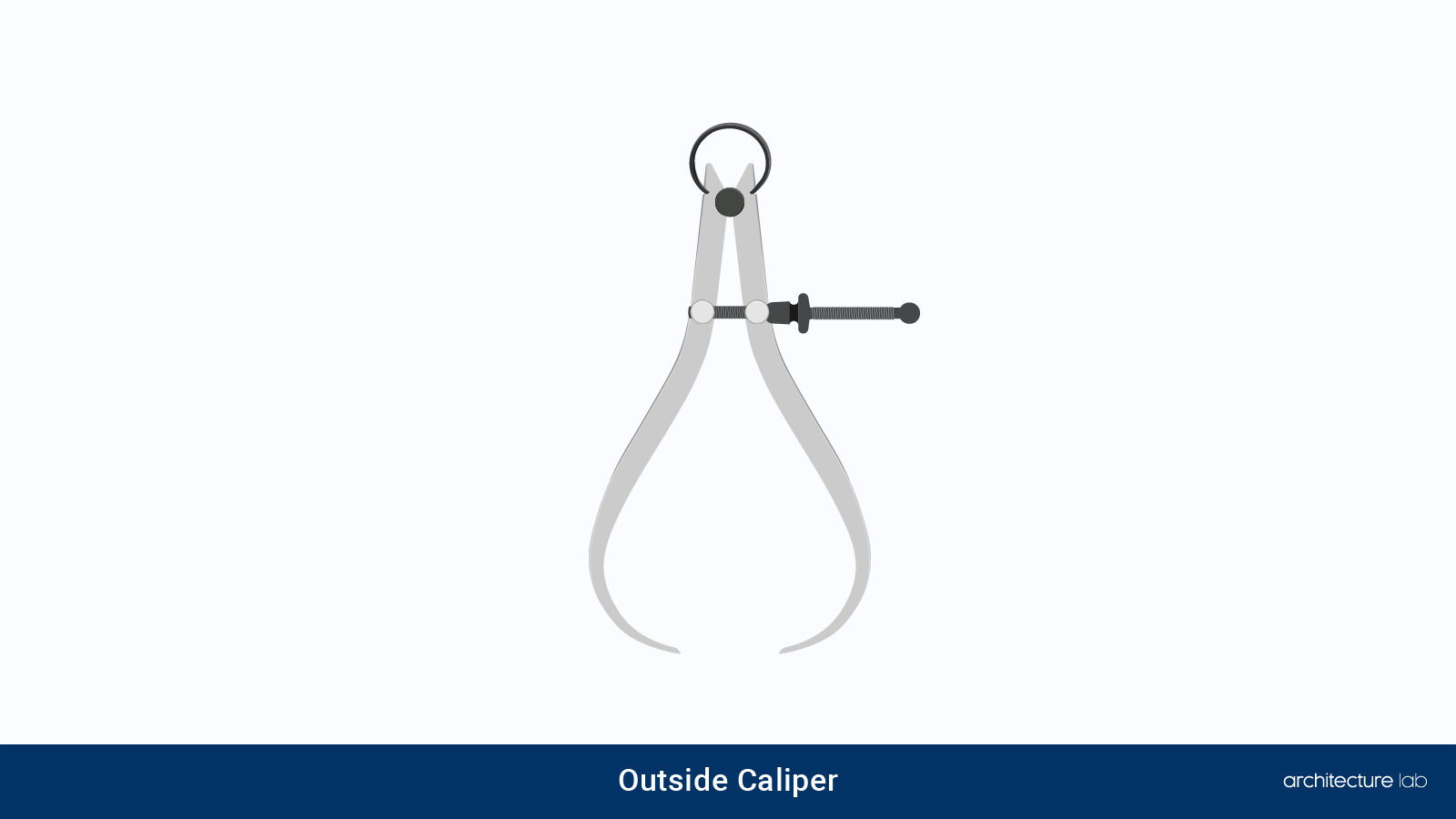
An outside caliper is a measuring tool used to measure the external diameter and thickness of a specimen. The bow-shaped arms (jaws) of outside calipers are used to measure external dimensions accurately. To do that, you have to open the jaws wide enough to accommodate the object and then bring them together to enclose the object.
Aside from its use in engineering, this tool is extremely helpful in other fields of study, too, like archaeology.
5. Inside Caliper
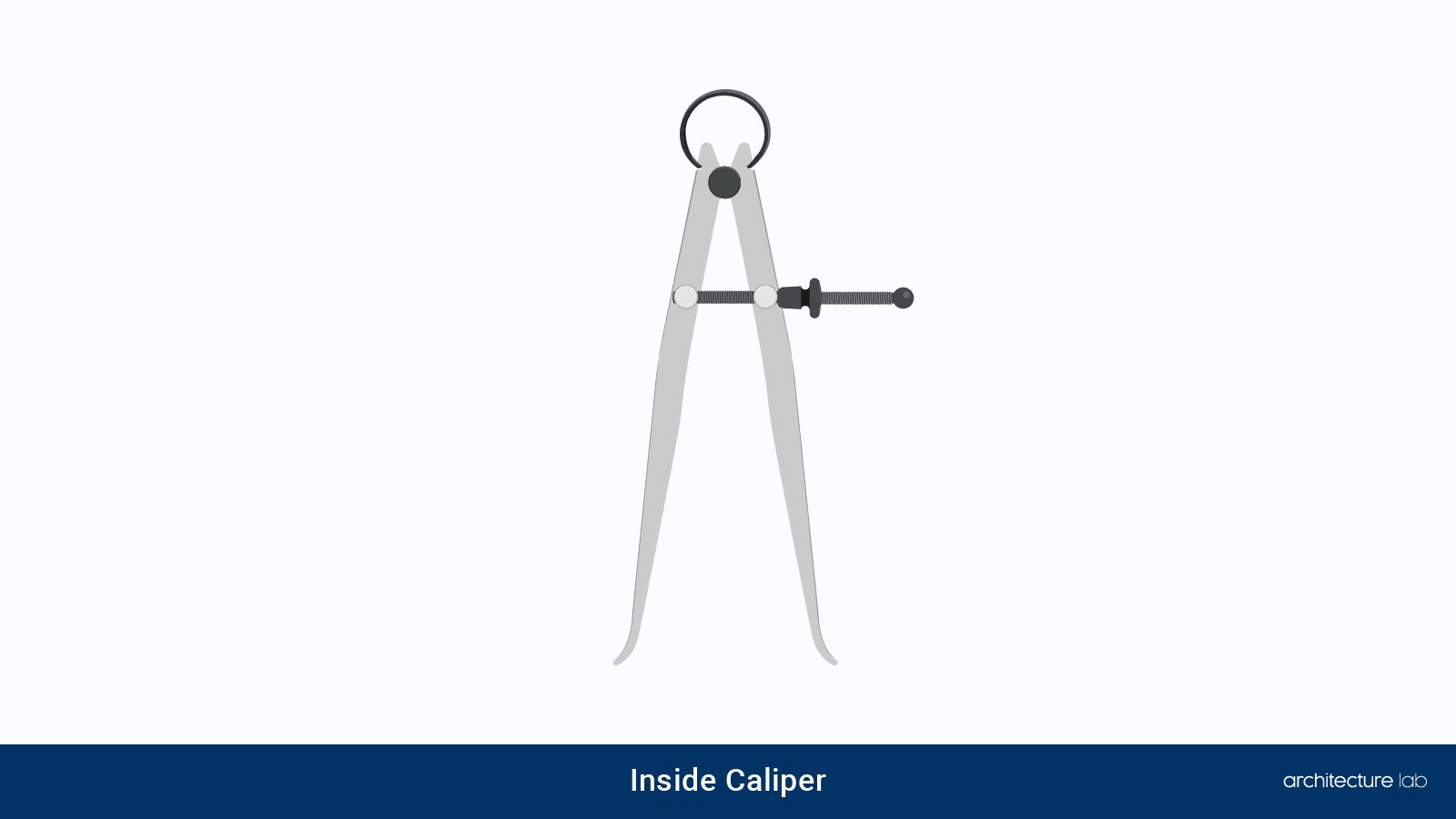
Unlike outside calipers, the inside caliper is used to gauge the internal dimensions of a given specimen. Being a precision instrument, an inside caliper is used to precisely and accurately measure the distance between objects and the diameter of the hole.
The jaws of the inside caliper are curved outside, which are adjusted to take accurate readings of the given object
6. Vernier Height Gauge
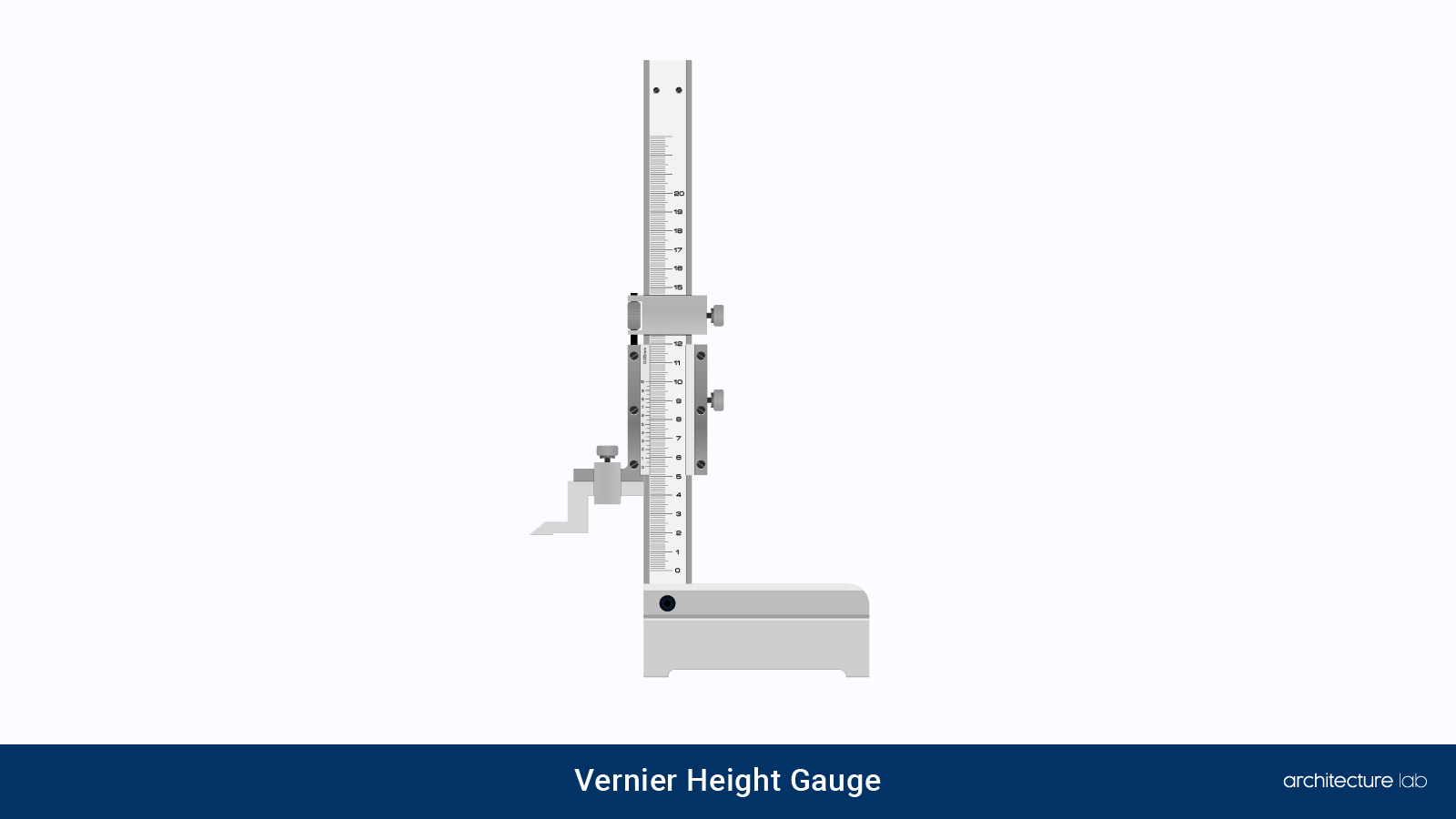
Vernier height gauge is used to precisely and accurately measure the vertical dimensions of a given surface. The vernier height gauge consists of the main scale and a sliding vernier scale. The main scale is fixed atop the vertical base, which also features a vernier scale.
In metalworking industries, the gauge is equipped with a scribing tool that scribes the vertical distances being measured. Like the vernier caliper, the reading accuracy of the vernier height gauge is 0.02 mm.
7. Micrometer
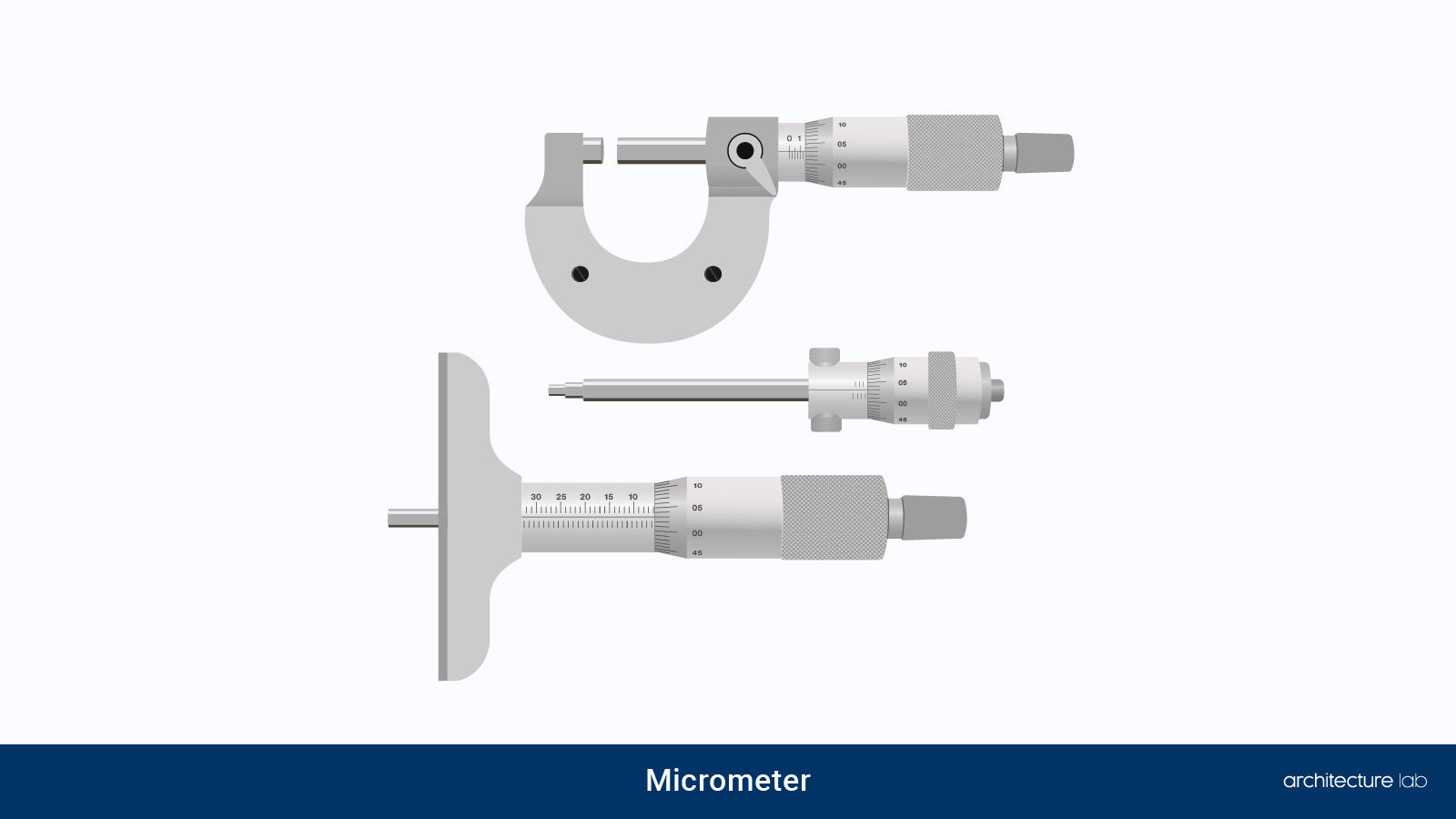
A micrometer or micrometer screw gauge is a measuring tool used to gauge precise measurements of small objects. The diameter, thickness, and length of objects like valves or pipes are accurately measured using a micrometer which features an accuracy of 0.01 mm.
Objects are measured by enclosing them in an anvil and spindle and noting precise measurements from the thimble. Different types of micrometers are used to measure different surfaces.
8. Radius Gauge
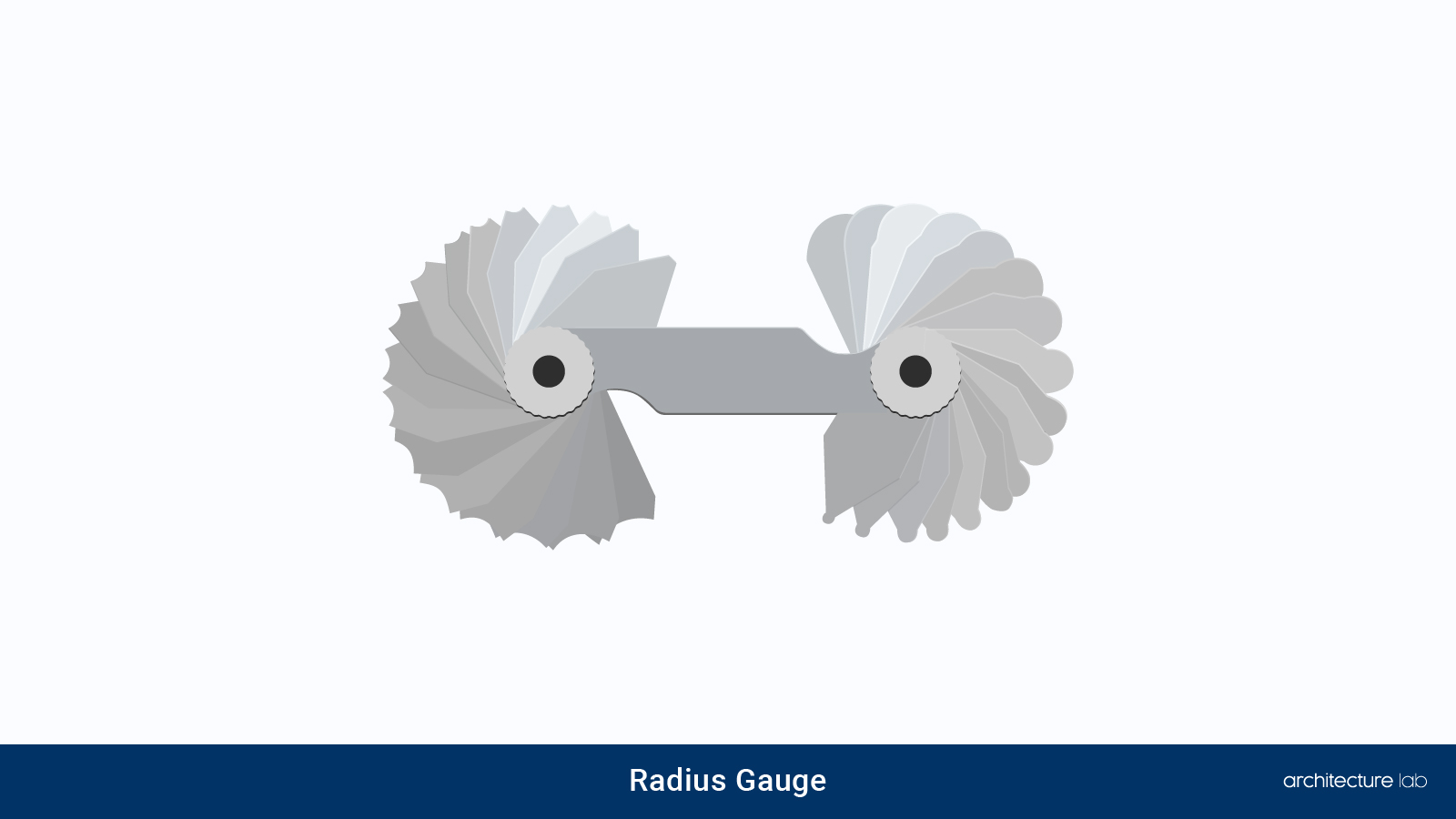
Radius gauge, as the name suggests, is used to measure the radius of a given object. Convex and concave radii are measured using this tool. The radius gauge is usually made of stainless steel and features two leaves on edges that carry concave and convex blades for measurement.
These projections on either end are checked against the given surface in bright light to record accurate measurements.
9. Spirit Level
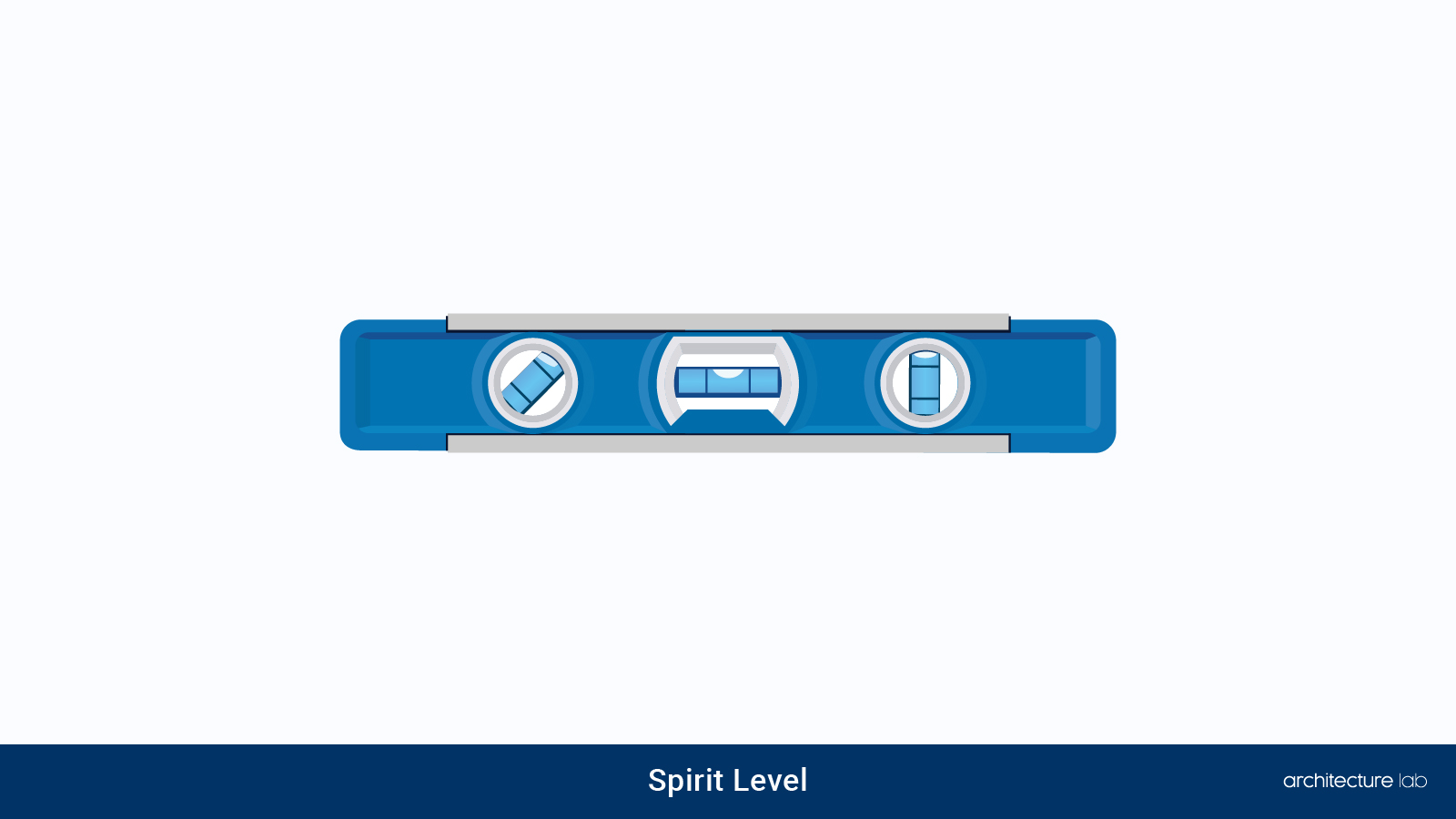
In mechanical engineering, a spirit level is extremely important to level machines. The engineer’s precision level is used to level the beds or foundations of a machine.
Spirit leveling is used in several operations ranging from carpentering to building. Usually, the instrument operates on air bubbles that are trapped in a liquid (mostly ethanol). The air bubbles that are entrapped in ethanol in a tube are carefully analyzed to check the level of the surfaces.
10. Vernier Depth Gauge
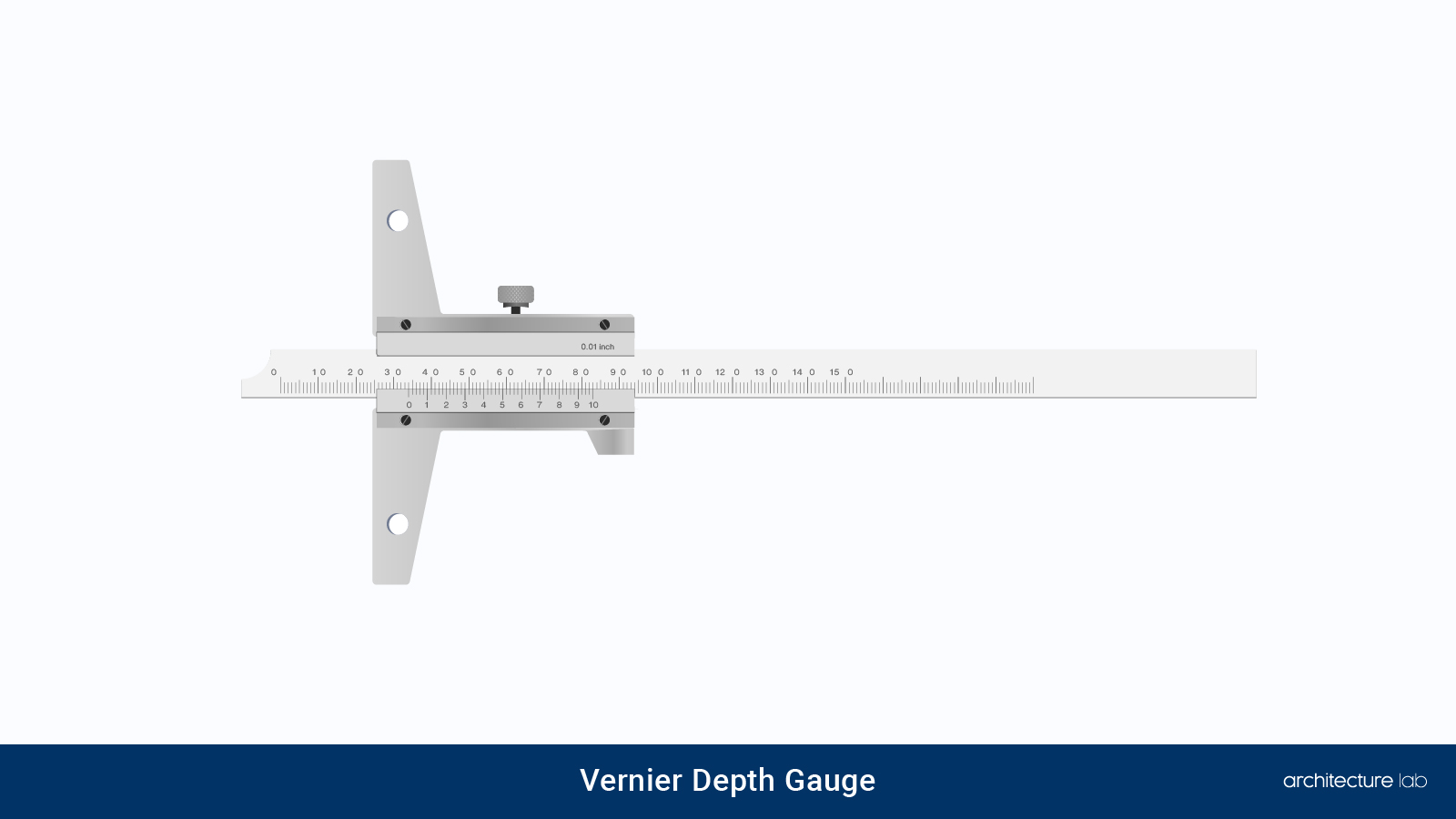
Vernier depth gauges are measuring instruments that are used to measure the depth of recesses, holes, or distance to the projected area. They feature a main scale and a vernier scale to measure the depth of a given surface precisely.
There are two kinds of vernier depth gauges, namely, digital and analog.
11. Outside Micrometer
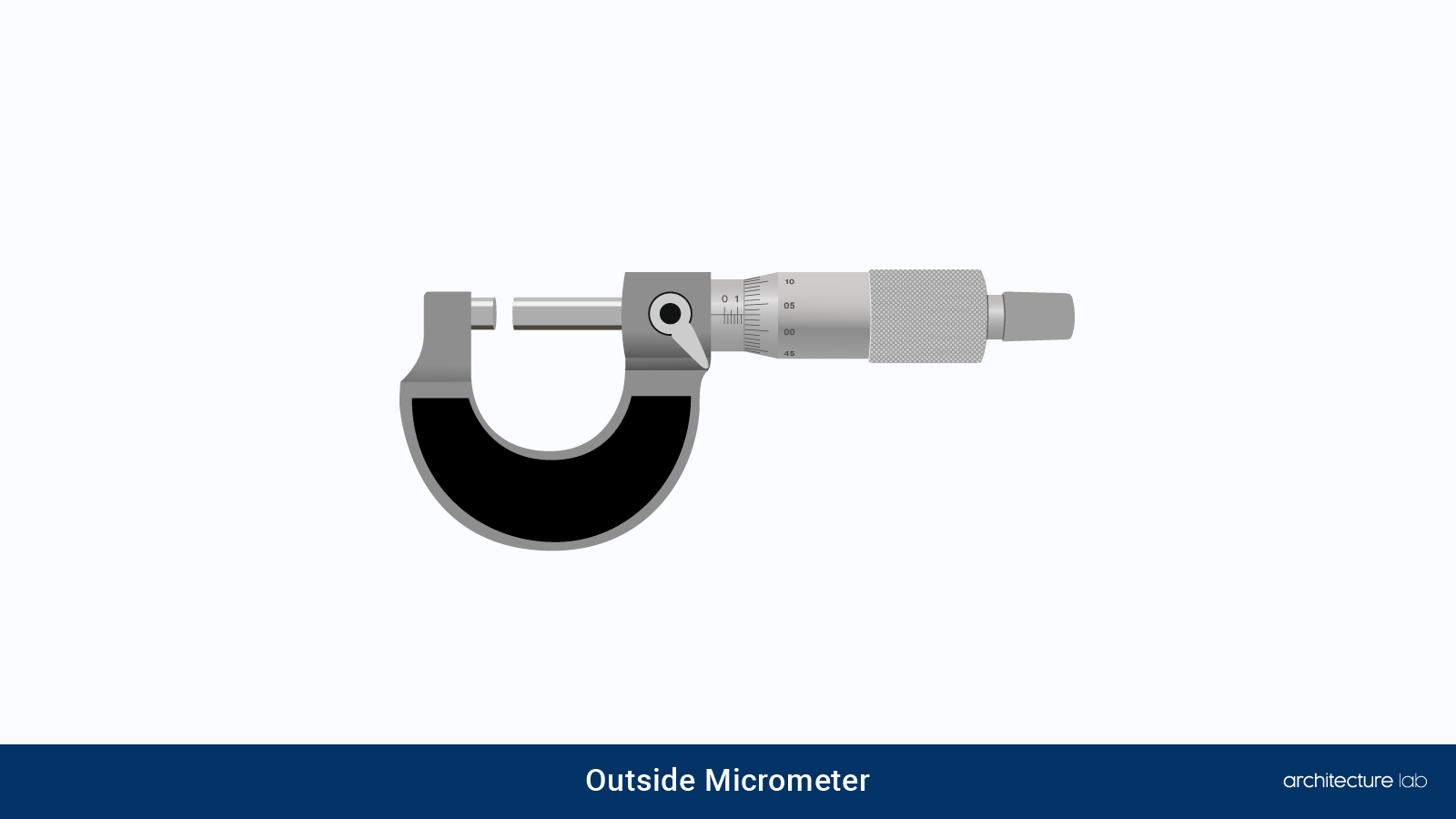
An outside micrometer is a measuring tool used by mechanical engineers to gauge the external dimensions of surfaces. They are used to precisely measure the depth or thickness of small objects that are otherwise difficult to measure.
Typical outside micrometers feature a measuring range of 1 inch or 25 mm. However, this range can vary too.
12. Vernier Bevel Protractor
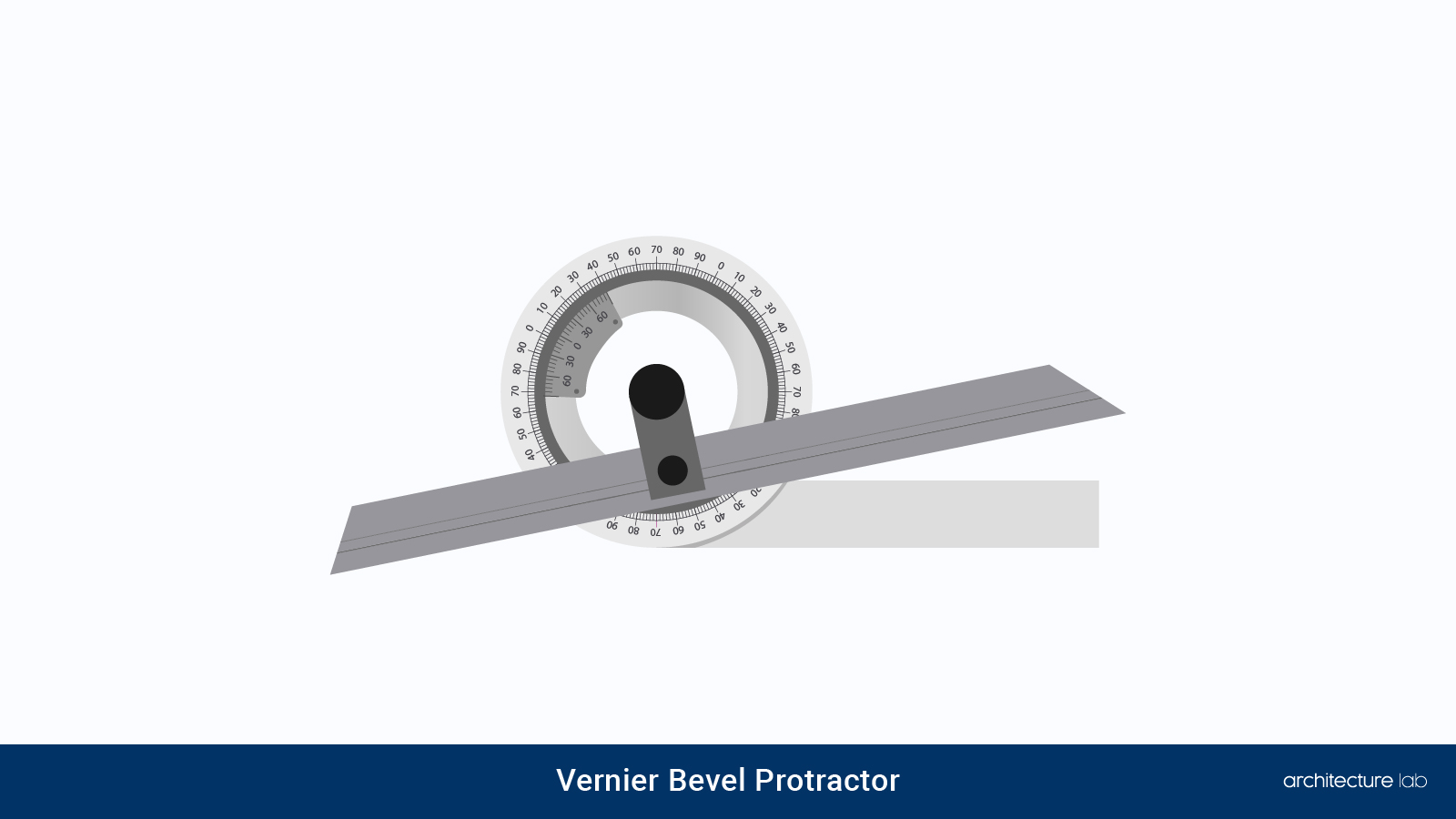
Vernier bevel protractors are measuring instruments used to precisely measure or mark angles. They play an instrumental role in mechanical architectural design. However, their usage is decreasing with the employment of CAD.
Vernier bevel protractor features a graduated scale and a vernier scale to give accurate measurements of angles. It measures angles ranging from 0° to 360° with a reading accuracy of 5 arcminutes.
13. Sine Bar
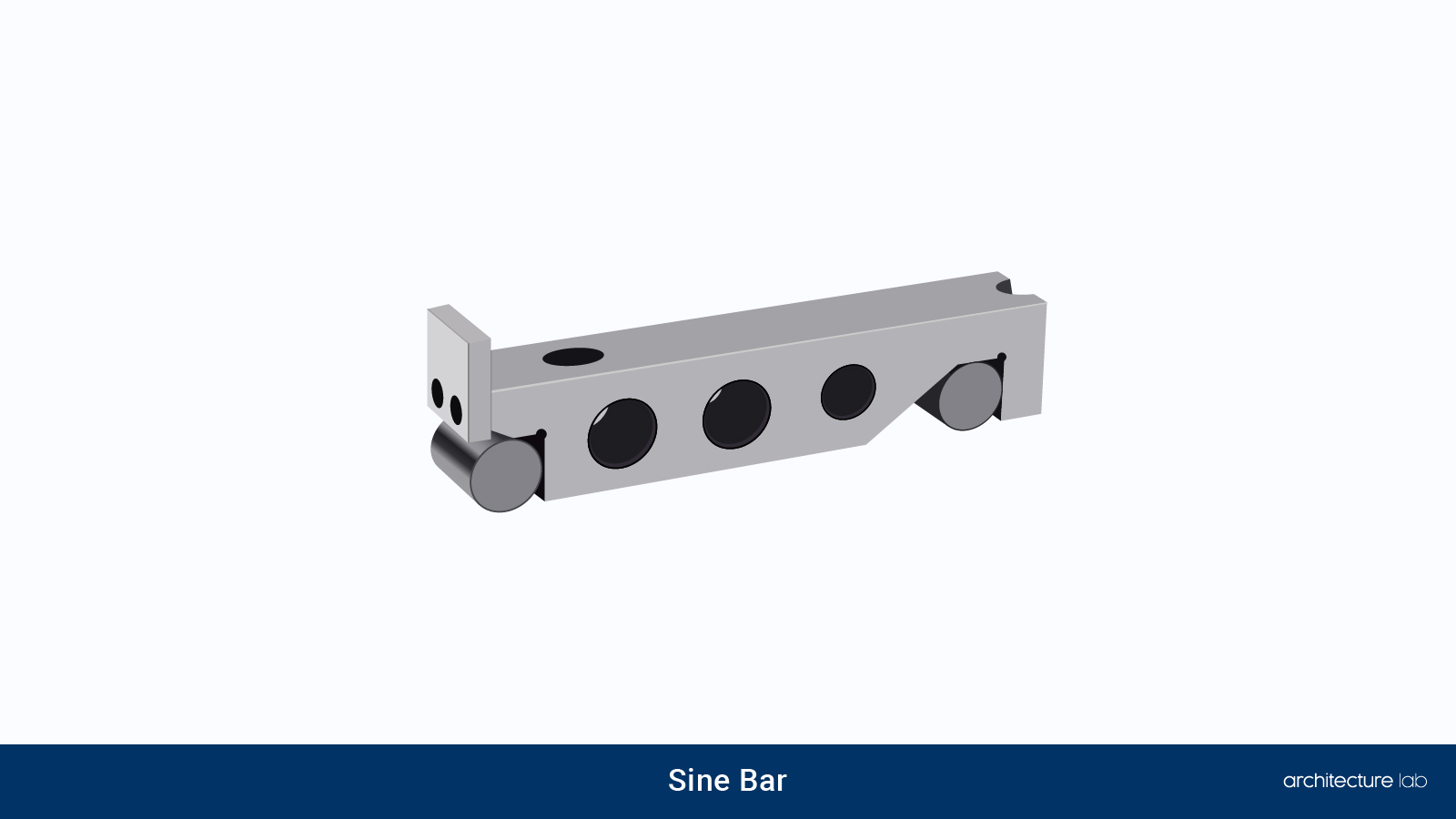
Sine bars are angular measurement tools used with slip gauges to accurately measure angles and position a workpiece to a correct alignment. They are made of high chromium and corrosion-resistant metal and feature two cylindrical bars of equal diameter on either end.
The working of the sine bar is established on the law of trigonometry, and it gives an accurate measure of angles in workpieces.
14. Surface Plate
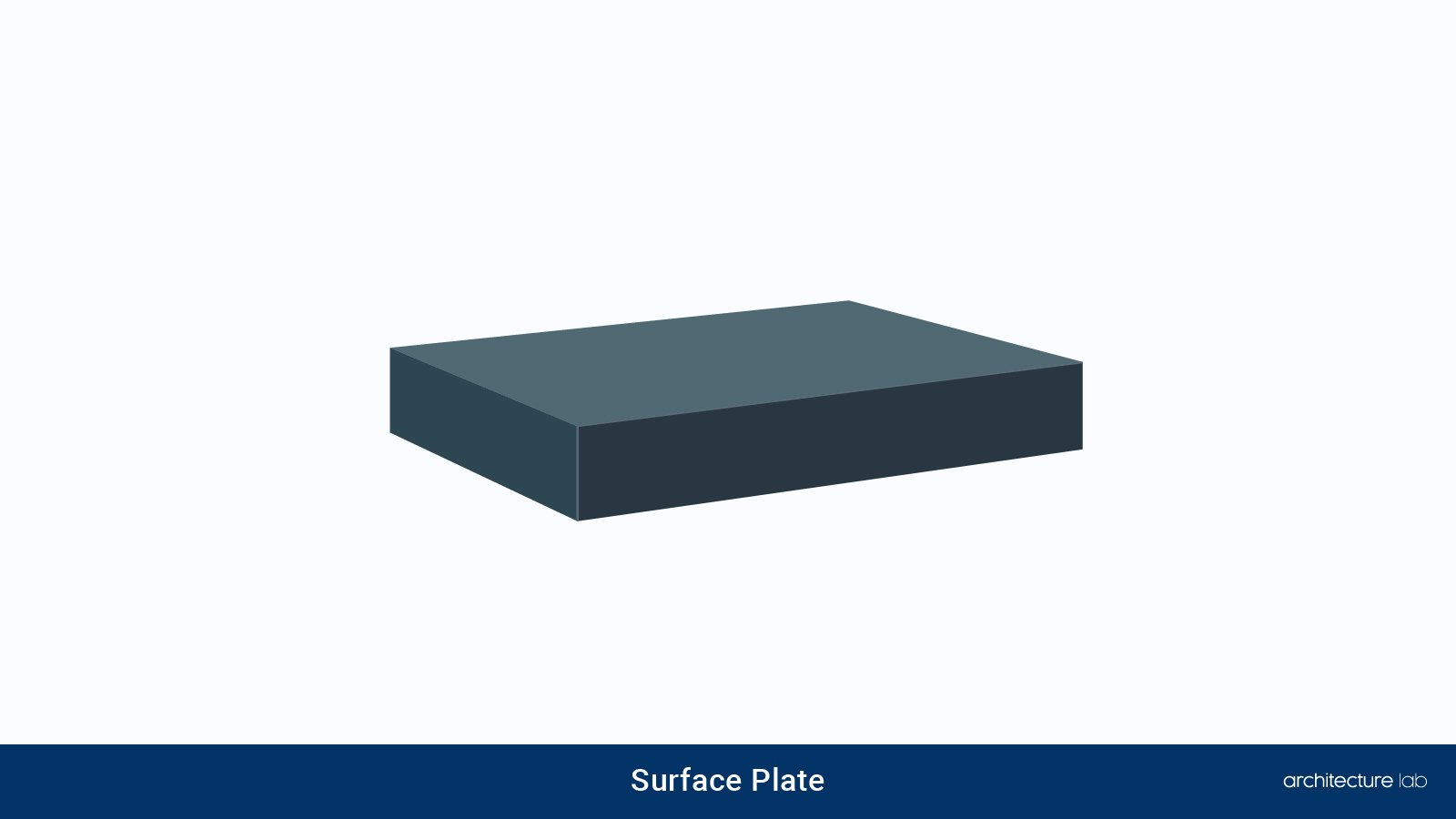
A surface plate or true plane surface is a measuring tool used to take dimensional measurements. These are flat and are made of granite, glass, metal, or cast iron.
They act as a base for toolmaking, gauging, inspecting, laying out, etc. Surface plates are used in conjunction with other measuring tools such as sine bar, dial indicator, height gauge, etc.
15. Laser Tape Measure
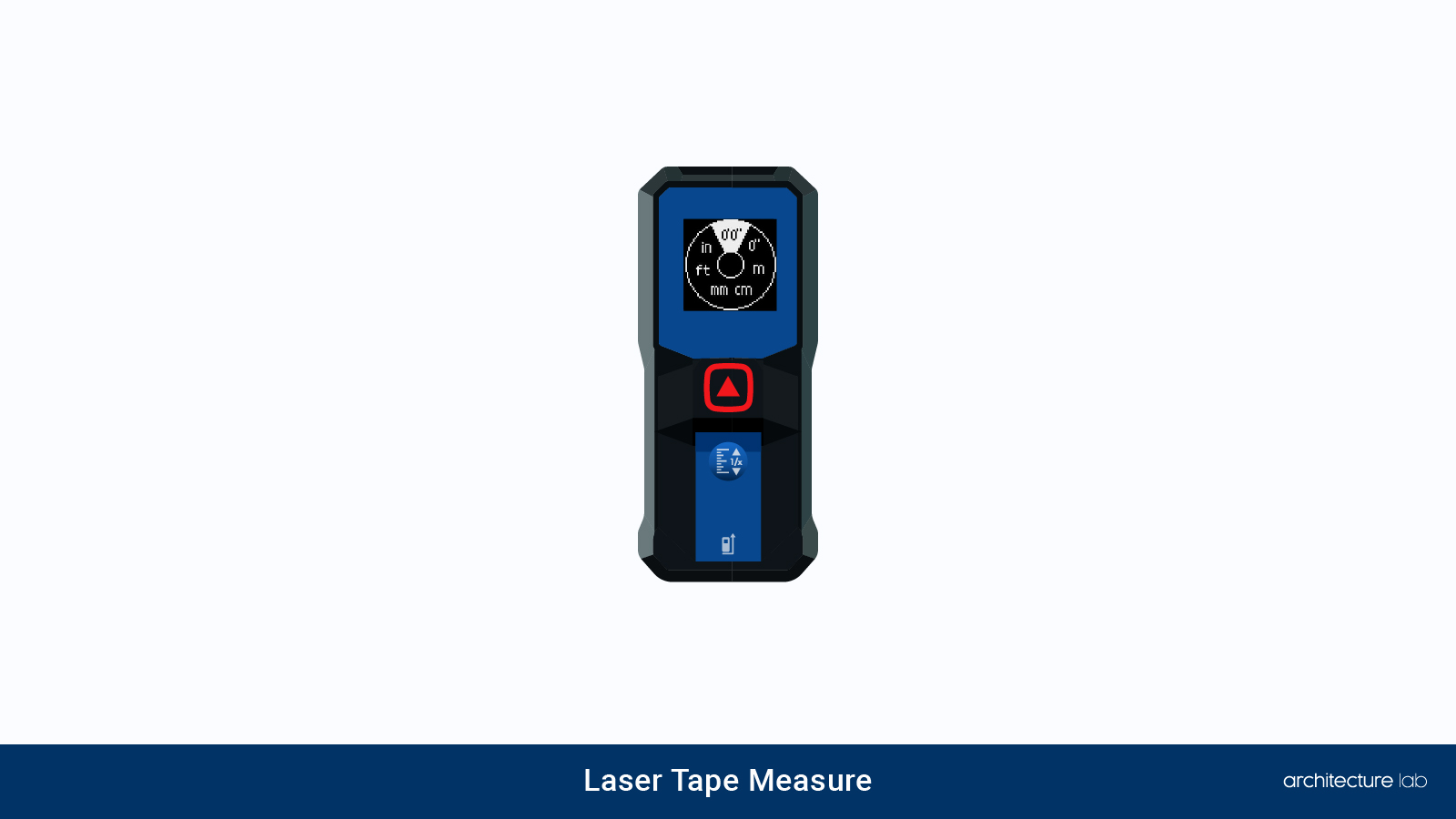
Laser tape measures are measuring tools used to calculate the distance between two points. Measuring distances using lasers has become easier using multimode and user-friendly devices. The focused beam of light (laser) is used to measure the distance as, unlike white light, the laser light doesn’t disperse and maintains its intensity.
The device emits the light, and once the light hits the target surface, it gets reflected back to the device. The laser device uses this reflection time to measure distance. However, the accuracy of such calculations can vary.
16. Digital Protractor
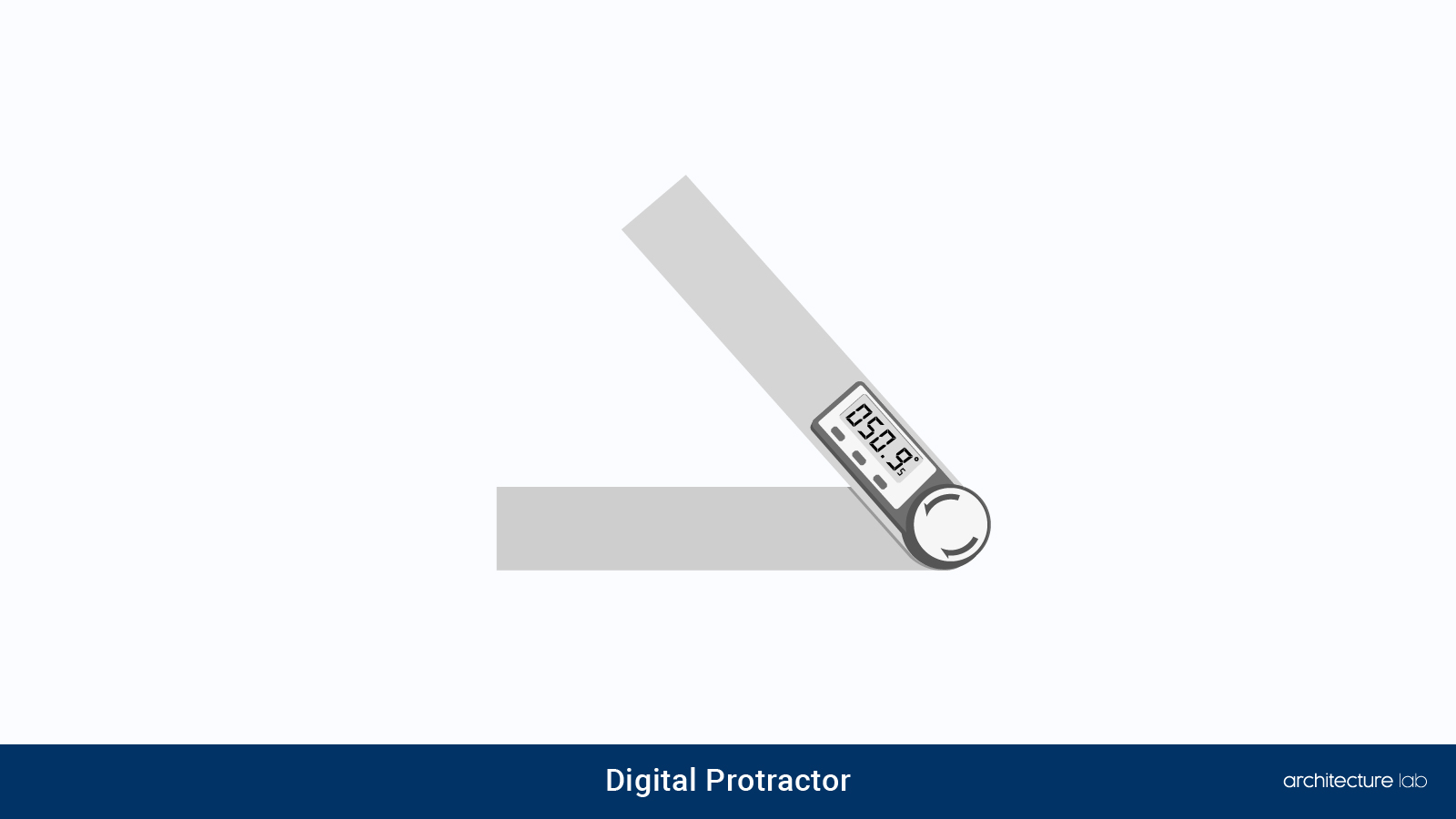
A digital protractor is used in measuring angles between surfaces and is extremely easy to use. It measures angles within the measuring range of 360 degrees with an accuracy of 0.1 degrees. These electronic protractors are more efficient in measuring angles than hand-held protractors.
The screen displays the angular readings of the specimen being measured and provides reliable results.
17. Divider
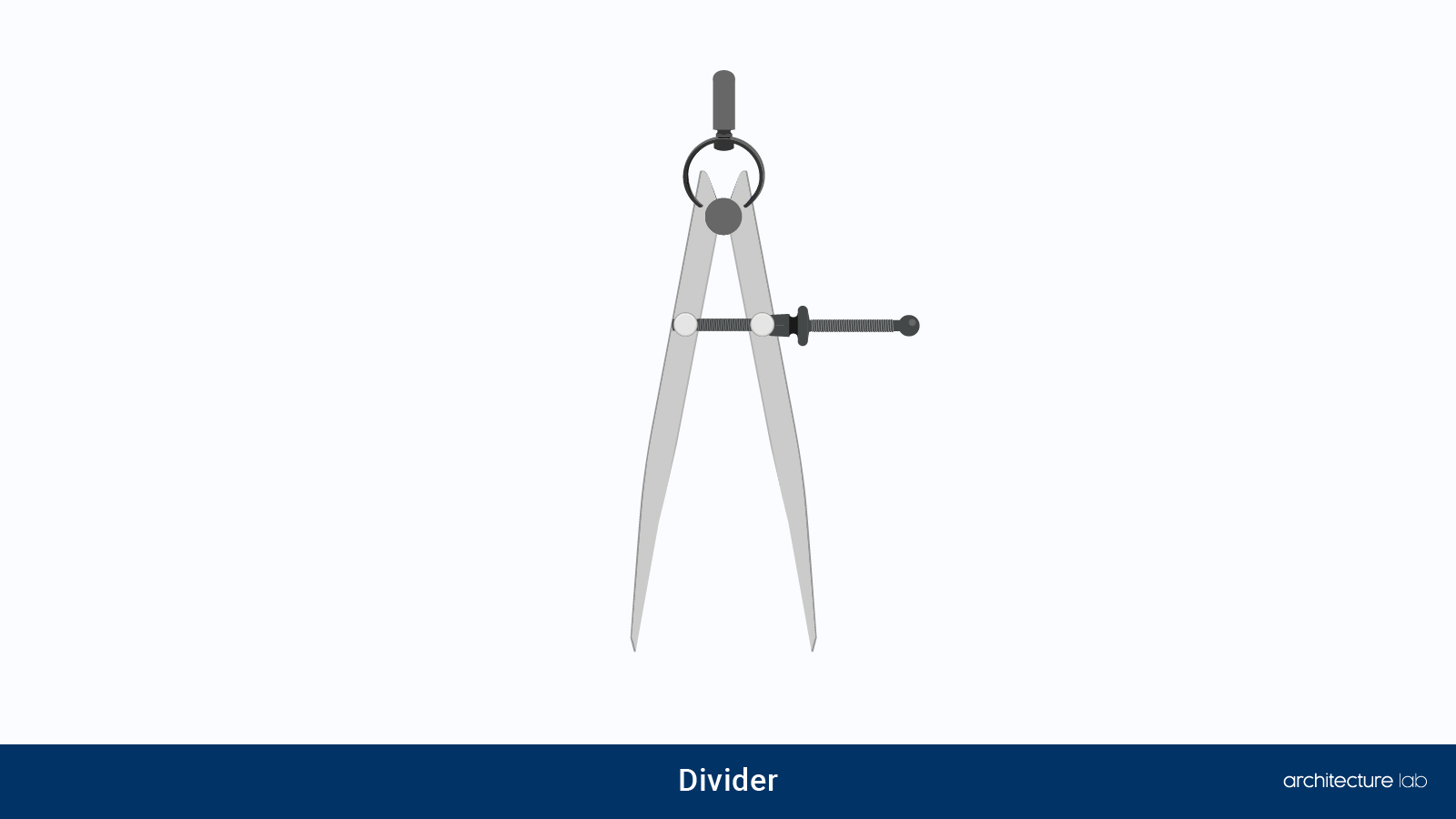
Dividers are linear measuring instruments used to mark, transfer, or measure distances. The two adjustable legs of the divider are used to scribe circles. The sharp edges of the legs act as a scribe to mark measurements.
They are mainly employed to precisely take and transfer dimensions from a ruler to the surface.
18. Depth Micrometer
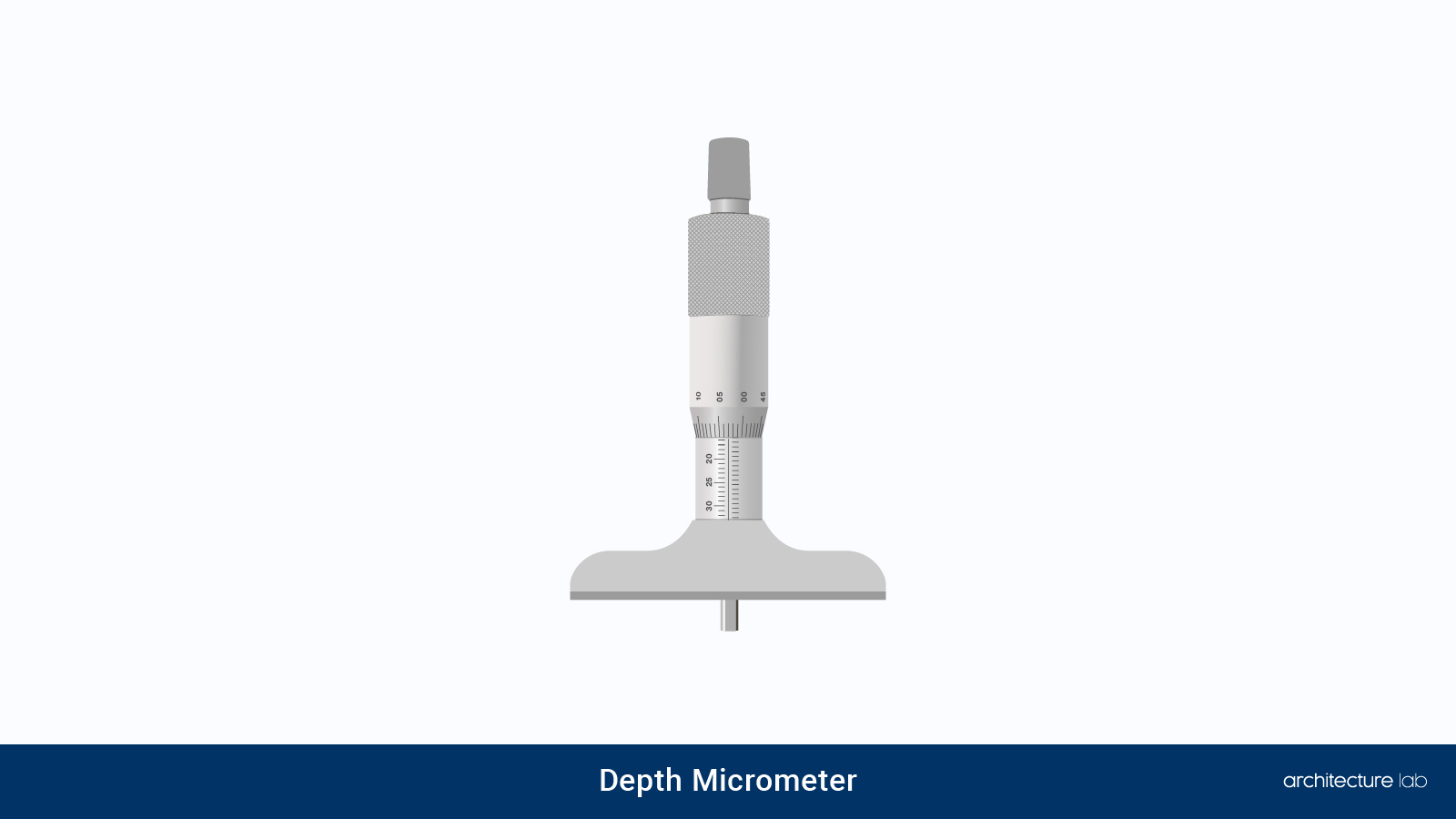
As the name indicates, a depth micrometer is used to measure the depth of a given surface. The depth of small bores or holes is usually measured with the help of this instrument. It offers an accuracy of 0.01 mm with a measuring span of 25 mm.
To get accurate readings, the spindle of the micrometer must be gently and carefully positioned on the surface.
19. Odd Leg Calipers
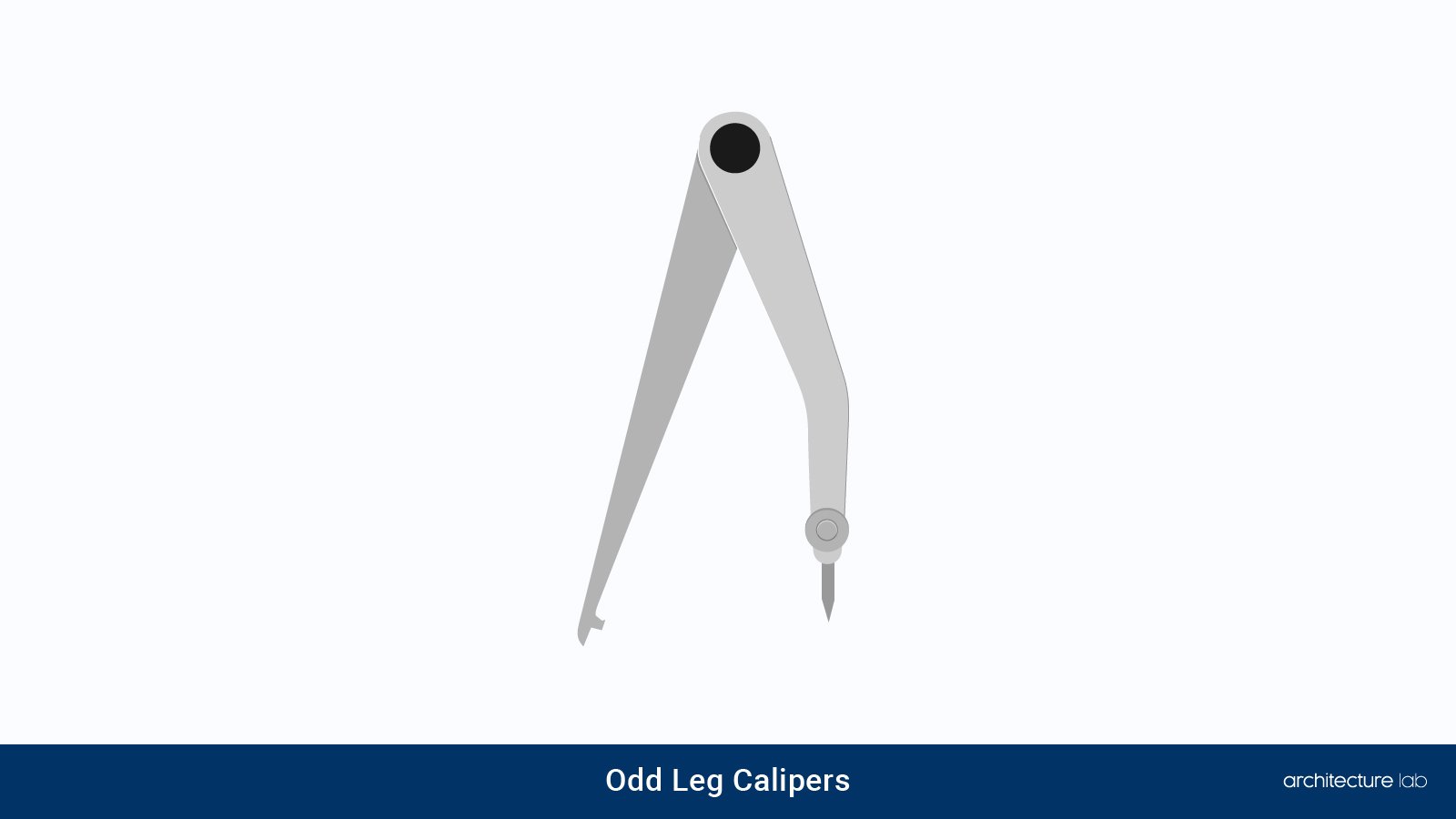
Odd leg calipers or Jenny calipers are measuring instruments that feature a bent leg with an adjustable divider point. They are used to locate points or scribe lines from the edge of a workpiece.
While keeping one leg fixed, the caliper is used to measure or scribe and works somewhat like a regular compass.
20. Feeler Gauge
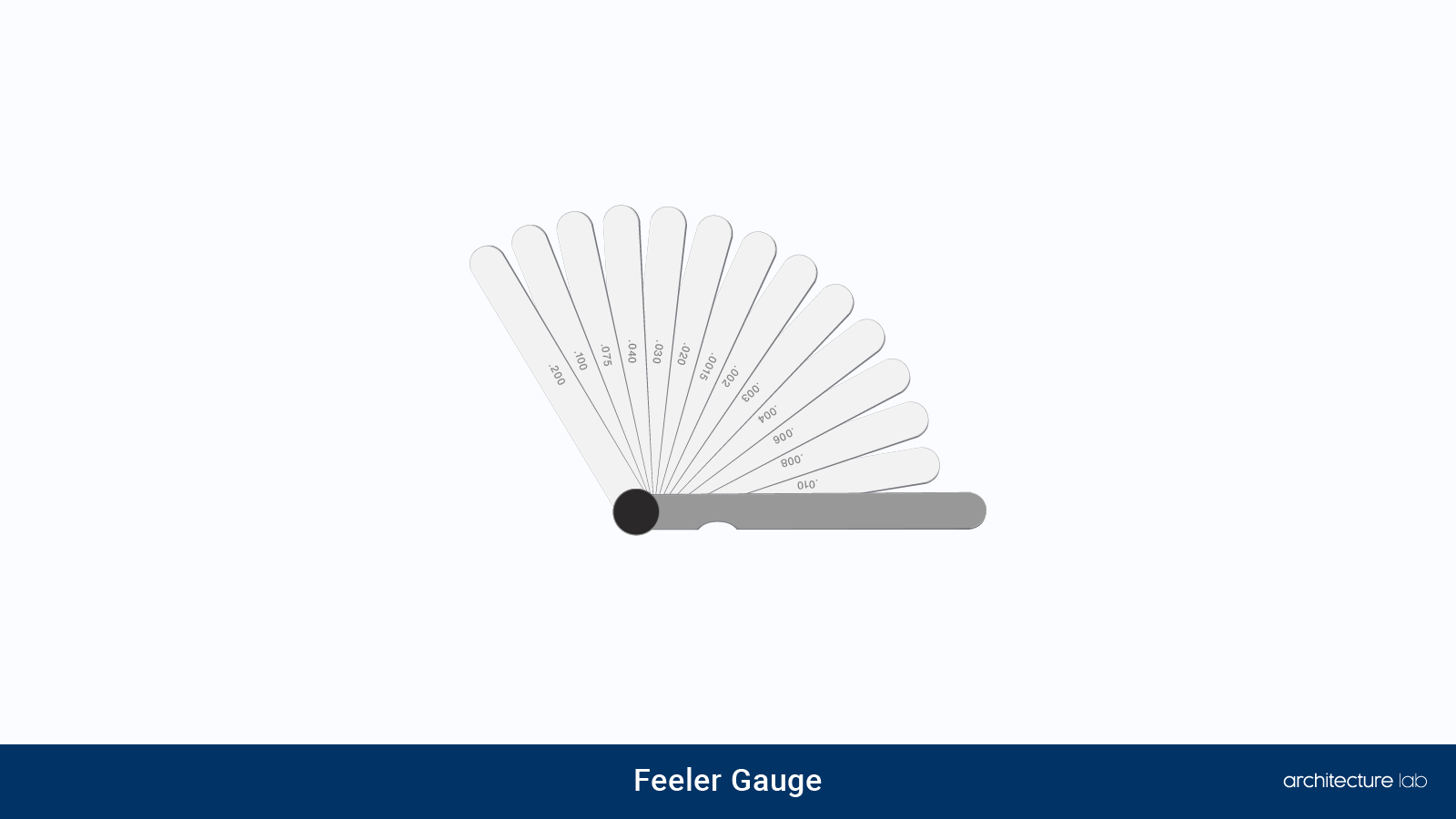
Feeler gauges are one of the types of measuring tools that are used to find gaps between two objects that lie close to one another. They are important gap-width measuring tools in engineering and feature small steel blades that vary in thickness. These blades are marked with measurements and are flexible enough to provide readings between gaps.
These metal strips are inserted in the gaps between the given specimen to take note of the measurements between the gaps.
21. Slip Gauge
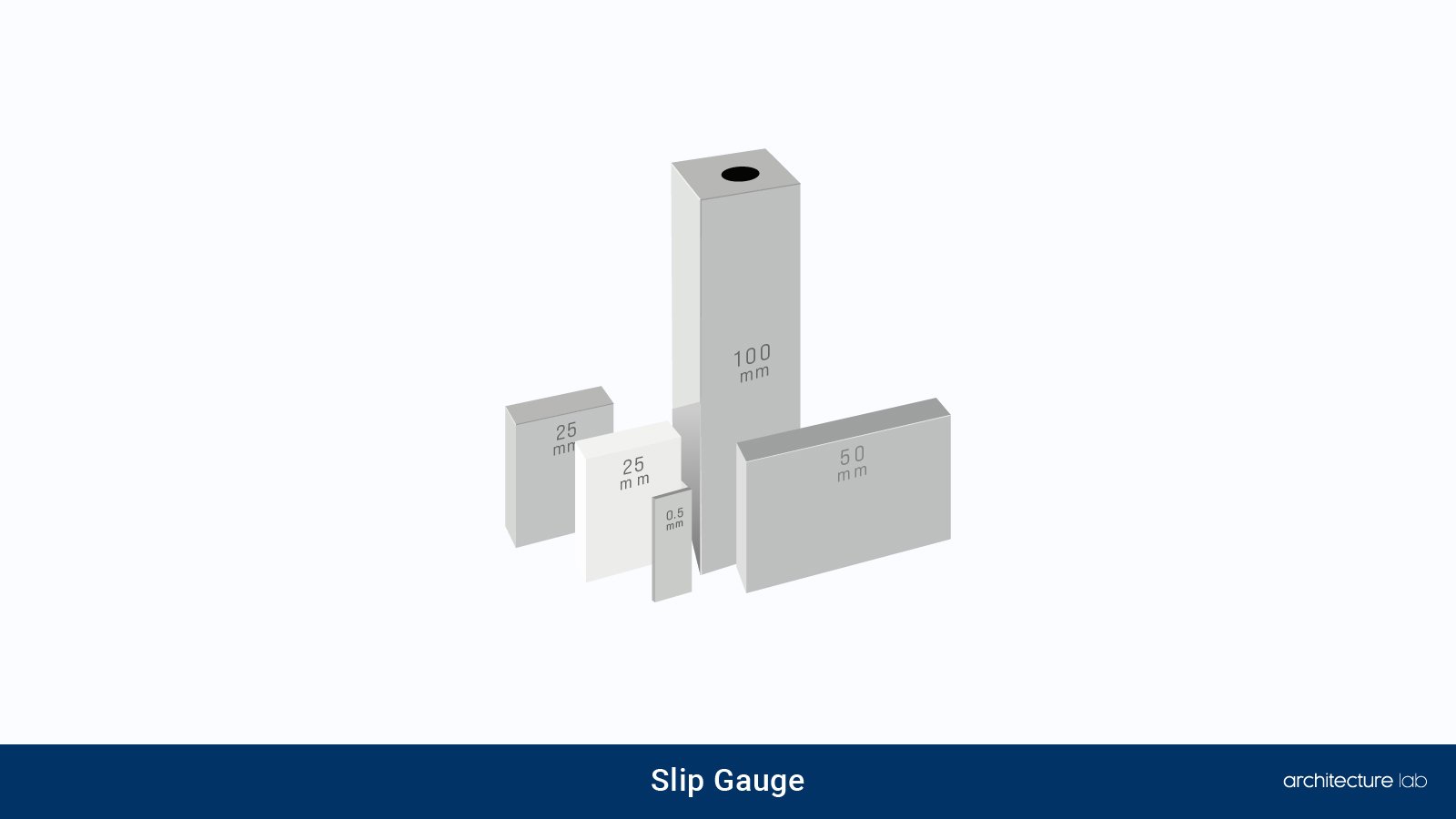
Slip gauges or gauge blocks are used as a standard system of length measurement. They are ideal measuring standards in engineering and consist of high-grade steel blocks with a cross-section of 32 mm x 9 mm.
A slip gauge is a simple yet accurate linear measuring device.
What are precision measuring instruments?
Precision measuring instruments are devices used in various fields such as manufacturing, engineering, and science to take accurate measurements with a high degree of precision.
These tools, which include micrometers, calipers, and gauges, provide critical data that allow operations to adhere closely to specified tolerances, ensuring the quality and consistency of products or experiments.
How are measuring instruments classified?
Measuring instruments are typically classified based on what they measure, their operating principle, and their level of precision. For example, they can be categorized by application such as length, temperature, pressure, mass, or electric current.
They can also be differentiated by their operation—mechanical, electrical, optical, etc. Further, they can be grouped by precision from basic hand-held instruments to highly accurate laboratory instruments.
Which engineering tool is used for measuring mechanical parts?
The engineering tool that is commonly used for measuring mechanical parts is the micrometer. It provides highly precise measurements of small dimensions and allows engineers to obtain sizes with close tolerances.
For larger dimensions, tools such as calipers, including vernier and digital calipers, are often used. The selection of the measurement tool depends on the specific requirement of the task.
Why are gauges used?
Gauges are used because they provide accurate and direct measurements of physical quantities such as pressure, temperature, depth, thickness, or speed.
These measurements are essential in monitoring, controlling, and troubleshooting various systems in both industrial and domestic settings, thereby ensuring safe and efficient operations.
What is the difference between a micron and a micrometer?
The difference between a micron and a micrometer is essentially just in their names, as they both represent the same unit of length—one millionth of a meter.
“Micron” is an informal term, while “micrometer” is the official term recognized in scientific and international standardization contexts. Both represent the same measurement unit.
This was all about measuring instruments used in engineering. We hope you were able to differentiate between different measurement tools after reading our piece.
Knowledge of measuring instruments and their application is vital in engineering and other related fields that require precise measurements. Every tool has a different purpose and gives a different accuracy. Thus, knowing which tool would be perfect for a particular specimen becomes important.
And that’s a wrap. Until next time, keep building!


